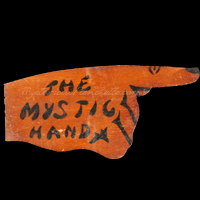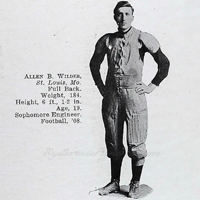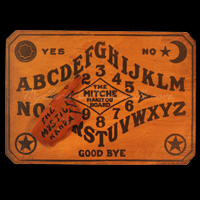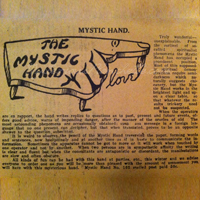Talking board collectors may first think it odd to find a picture of the Mystic Hand planchette included in the American Planchette Gallery for automatic writers. It is, after all, a popular and well-known pointer for the highly-collectable Mitche Manitou talking boards produced by the Wilder Manufacturing Company of St. Louis, Missouri. But recent research has brought an interesting variation of this popular pointer to light, in that the company also produced the design as a writing planchette, as evidenced by the discovery of a full-page ad in the ten-cent "Gypsy Fortune Teller and Dream Book" published in the 1920s. We've used its twin as a stand-in until such time as a redicovery of one of these gems is made.
The Wilder Manufacturing Company was located in St. Louis, Mo, where it was incorporated in 1914 with a capital stock of $100,000, $65,000 of which came from the initial shareholders. The company was founded by Allen B. Wilder to manufacture toys and other trade goods. Interestingly, Allen Wilder did not hold initial stock in this company, and the incorporators -among them his father, Edward B. Wilder, and partners Harry M. Pflager, Obed W. Stone, Charles W. Glorius, William E. Candy, and James A. Carr -divided 840 shares of company stock between them. This new entity was intrisically tied to the Wilder Patents Company, with the same investors, who owned patents on die machinery used to manufacture the goods.
Allen Bliss Wilder seems a man of means. His father was president of the Day Rubber Company of St. Louis -a profitable business to be in both then and now. Father and son seem to have gotten along nicely in business together, and in 1912, the two secured consecutive patents for wood-cutting dies that would prove useful in their later manufacture of toys and other wood and leather goods. As for Allen, he enjoyed similar fruits of his father's success at an early age, attending prepatory school followed by enrollment at the Univeristy of Missoury-Columbia as a Mechanical Engineering student, where he was a member of several fraternities and honor societies, including Phi Kappa Psi, Zeta Chi and the Druids. He was a handsome and imposing man, with a square jaw, heavy eyes, and height in excess of 6-feet, which was tall for the age. This no doubt served him well as a standout member of the school's track and football team, where he played fullback. Apparently, he met his future wife, Miss Sally Marguerite McCluer, while attending university, because his alumni personal effects collection at the college contains a calling card bearing her name.
What brought the father-and-son team into the toy business is unknown, but they were good at it, not only securing the aforementioned patents on the machinery used to produce the goods, but patenting their own games as well as "jobbing" them for other companies. The firm manufactured Tiddlywinks, Touchdown Football Game, Ocean to Ocean Flight Game, and paper kites, among many others, and is known to have produced toys for Presto Novelty. When the talking board craze roared into the 1920s, the company jumped on the bandwagon, and produced two classic and beautiful talking boards: the "Mitche Manitou" boards, complete with the "Mystic Hand" pointing planchette. The boards are beautifully stylized, with sweeping, pointed archs of letters and a distinctive diamond-shaped logo. While it is unknown why Wilder named his boards after Mitche Manitou (an evil Native American spirit of misfortune often characterized as a boogeyman in western and frontier dime novels of the period), he may very well have picked up the phrase in his college years through popular literature of in pseudo-mystical society rituals with Druids fraternity.
Less is known about the "Mystic Hand" writing planchette beyond what is presented in the advertisement. From the illustration, it seems likely that is was little more than a refitted pointer from the talking board line, with a pencil standing in for the third leg of the device. It seems unusual that castors were not added or that the pencil seems irreplaceable (thus confounding us on the item's continued use once it was sharpened too many times), but it is probable that the company produced the items cheaply to take advantage of the post-war bump in spirit-communication paraphernalia. It is unknown if the planchette was any larger than the rather diminutive pointer for their talking boards, but we hold out hope for the rediscovery of this gem so that we can find out! If you have seen one, please contact the curator immediately!











